Introduction
- “Two primary explanations for how persons are able to attribute mental states and emotions to others” are offered by researchers: Theory Theory (TT) and Simulation Theory (ST) (Dvash & Shamay-Tsoory, 2014, p. 288).
- According to Wiltshire, Lobato, McConnell, and Fiore (2015), these theories have derived from developmental psychology and neuroscience, being a part of Theory of Mind.
- This presentation aims to overview and critically evaluate TT and ST, discussing their primary characteristics, strengths, and weaknesses.
- Also, the relevance of these theories for the understanding of the social deficits in autism will be observed.
According to Dvash and Shamay-Tsoory (2014), two primary approaches to the attribution of emotional and mental states exist: Theory Theory (TT) and Simulation Theory (ST). These methodologies derived from the Theory of Mind as well as from developmental psychology and neuroscience (Wiltshire, Lobato, McConnell, & Fiore, 2015). Therefore, the purpose of this presentation is to observe principal aspects of each theory, including its strengths and weaknesses along with the elaboration of its relevance to the understanding of the social deficits in autism.
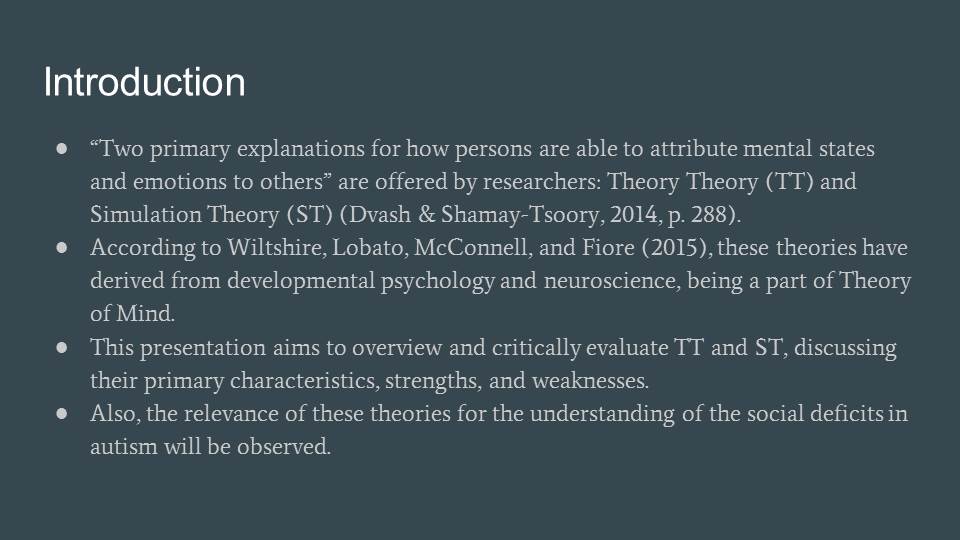
Theory Theory (TT) and Simulation Theory (ST): What are their primary aspects?
- TT’s primary premise is that the observer uses rational laws to explain other people’s mental states.
- TT derived from developmental psychology, and it implies the theorization of a mental realm (Dvash & Shamay-Tsoory, 2014).
- ST argues that people can use their own mind as a model of understanding.
- The mirror-neuron system plays a significant role in detecting other people’s mental states (Hamilton, 2013).
The principal premise of TT is that the observer develops his or her understanding of other person’s mind, employing causal and explanatory laws (Dvash & Shamay-Tsoory, 2014). This theory is popular among developmental psychologists, and it implies the theorization of a mental realm (Dvash & Shamay-Tsoory, 2014). On the contrary, the proponents of ST argue that that people can efficiently use their own mind as a model for understanding other minds (Wiltshire, Lobato, McConnell, & Fiore, 2015). It is also argued that the mirror-neuron system plays a significant role in detecting other people’s mental states (Hamilton, 2013).
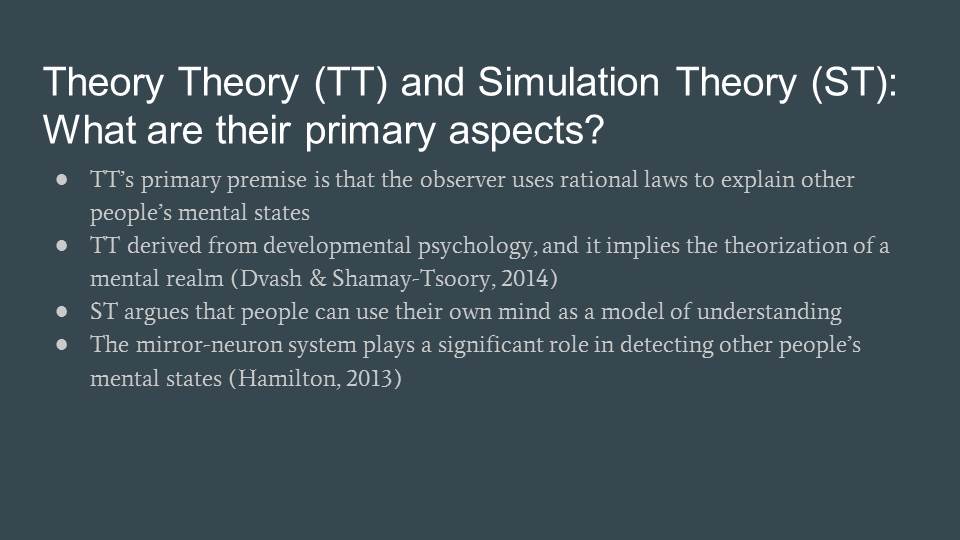
The Strengths of TT
- TT is vastly based on the profound research in developmental psychology.
- Various authors contributed to the development of the theory.
- TT is capable of explaining people’s mental states being independent from individual psychological characteristics (Michlmayr, 2002)
- The theory is vastly based on the empirical evidence, found in the works of Gergely, Bekkering, and Kiraly (2002), Hamilton (2013), Saxe and Kanwisher (2003), and many others.
First of all, it should be stated that the primary strength of the Theory Theory is that it functions by the means of employment of theorization as well as empirical evidence. The theory is deeply rooted in developmental psychology, and numerous researches have contributed to the evolution of the method. Another strength of the TT is that it is capable of explaining emotional and mental states disregarding individual psychology of the participants of communication. The validity of the theory is proven by empirical evidence, developed by various authors and researchers.

The Weaknesses of TT
Two primary challenges could be mentioned:
- From the behaviorist standpoint, TT used a somewhat detached position when investigating mental states;
- From the neuroscience perspective, TT lacks specificity in “about the nature of the ostensive mentalizing network” (Wiltshire et al., 2015).
It should be stated that the Theory Theory has two primary weaknesses, which are recognized by numerous authors, scientists, and researchers from various scientific areas. First of all, it is possible to note that from the standpoint of behaviorists, TT have a limited explanatory power due to its adoption of a “third person” perspective when observing social cognition (Wiltshire et al., 2015). The second challenge is imposed by neuroscientists, who argue that different parts of brain are active during social observation and social interaction, and thus TT lacks specifity (Wiltshire et al., 2015).
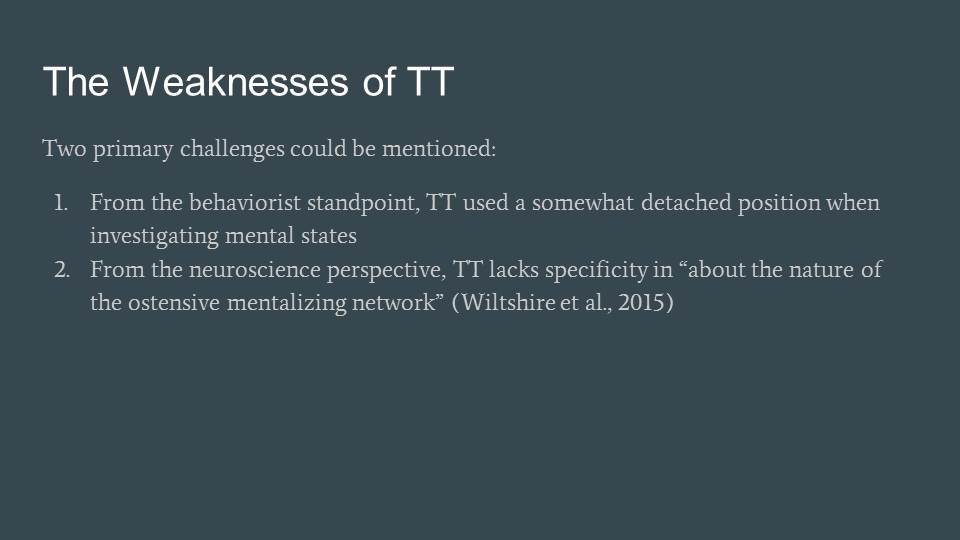
The Strengths of ST
- ST is also deeply rooted in the developmental psychology as well as in philosophy.
- The primary concept of the theory – simulation – makes it possible to explore individual’s mental and emotional state from a more emphatic position.
- ST is considerably more accessible and easier to employ than TT.
As it is mentioned by Michlmayr (2002), the Simulation Theory is deeply rooted in developmental psychology and philosophy. In particular, it is observed that philosophical views of Hume and Kant could be considered the initial form of simulationist psychology (Michlmayr, 2002). The principal premise of ST is that the process of simulation is the key to understanding other people’s brains. Simulation is defined as tracking and matching other individual’s mental state “with resonant states of one’s own” (Dvash and Shamay-Tsoory, 2014, p. 288). Also, due to its nature, ST is considerably more accessible than TT, and it is easier to employ ST for working in the field of social cognition (Gergely et al., 2002).
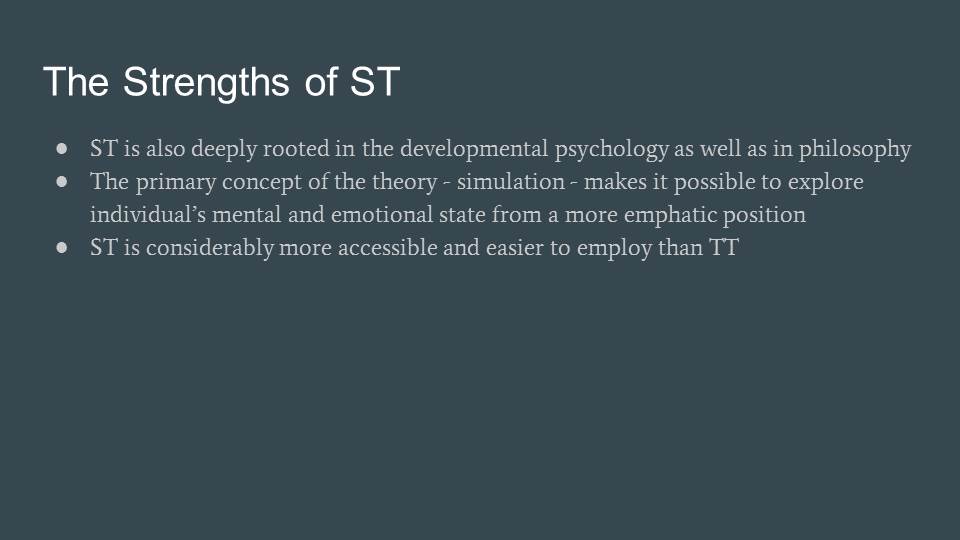
The Weaknesses of ST
Among the weaknesses of ST, the following aspects should be mentioned:
- The theory is not fully capable of describing social cognition due to its focus on observational aspect of mental processes;
- The theory is not so elaborately developed in terms of theorization and valid empirical evidence as TT.
Further, it is essential to discuss the weaknesses of ST. It is possible to mention two primary aspects here. Firstly, it should be mentioned that theory is often criticized due to its focus on observational aspect of mental processes (Wiltshire et al., 2015). Thus, the empirical evidence of ST primarily focuses on the stimulation through observation while numerous researchers indicate that social cognition primarily occur through interaction (Wiltshire et al., 2015).
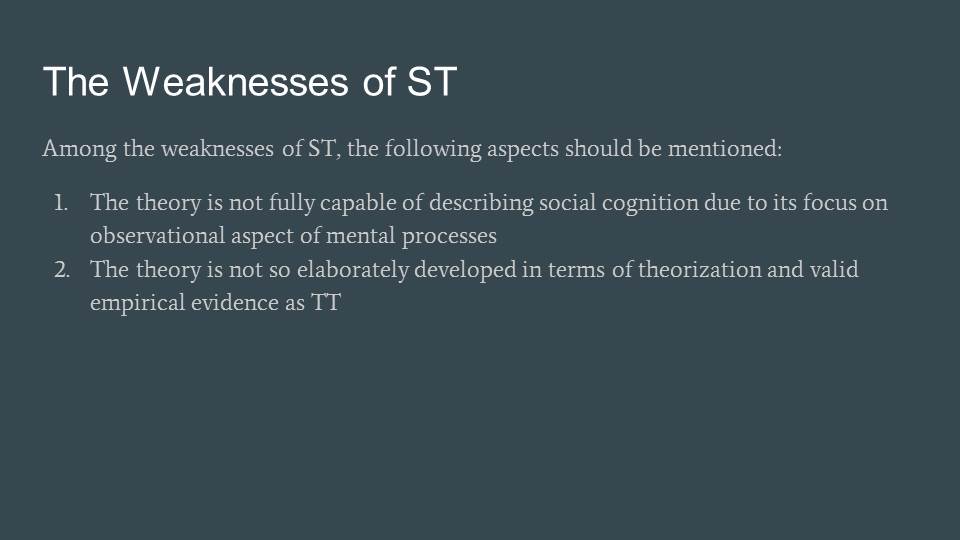
The understanding of the social deficits in autism in the context of TT and ST
- It is indicated that there are attempts to synthesize TT and ST for the development of a more comprehensive social cognition model (Wiltshire et al., 2015).
- One of the considerably perspective fields for the application of this theory is the social deficits in autism.
- Both theories imply that it is essential to cognitively understand the individual’s mental and emotional state to understand it.
- TT is capable of theoretical investigation of autism from biological standpoint.
- ST is beneficial due to the considerable potential for empathic interaction through the process of simulation.
It is of high importance to discuss the application of TT and ST to the improvement of the social deficits in autism (Michlmayr, 2002). First of all, it is evident that both theories, despite having somewhat different approaches to social cognition, share similar goal of understanding of other people’s mental states through the process of cognitive modelling (Wiltshire et al., 2015). TT would be significantly applicable because it deals with the theoretical investigation of mental states, disregarding the individual’s psychology (Wiltshire et al., 2015). ST is also high useful because it uses emotional empathy in the process of simulation, which is beneficial for the people diagnosed with autism (Michlmayr, 2002).
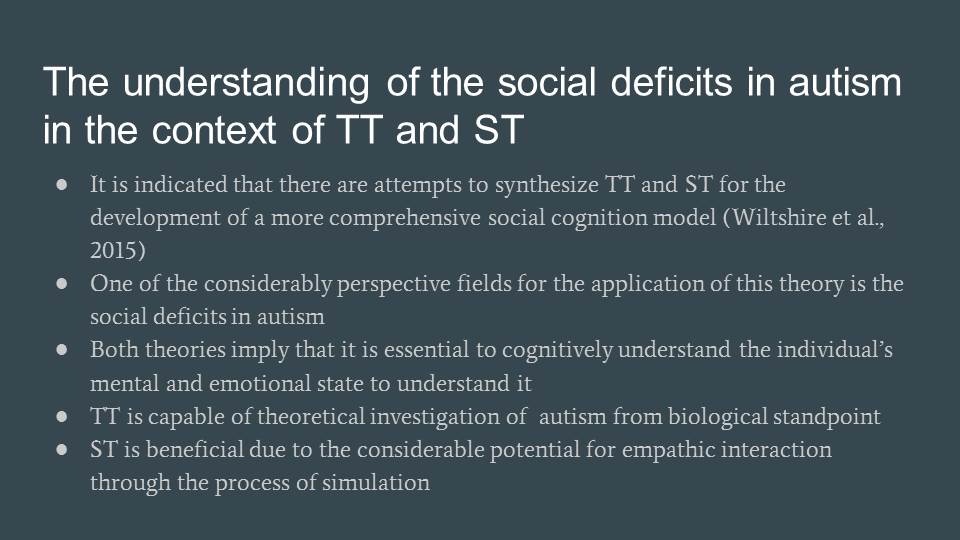
Conclusion
- Both theories, being part of the Theory of Mind, have considerable differences.
- Each of the theories possess a set of evident advantages along with considerable weaknesses.
- Theory Theory is primarily theory-based, detached approach to social cognition.
- Simulation Theory focuses more on emphatic and emotional aspects of individuals’ mental states.
- Both of the theories could be efficiently used to decrease the social deficits in autism.
Finally, it is essential to summarize the presentation by developing several important conclusions. First of all, both theories are included in the Theory of Mind, despite the fact that they have considerable differences. Secondly, it should be noted that this presentation overviewed both advantages and disadvantages of each approach. Thirdly, it is possible to summarize TT the following way: it is a method, which is primarily theory-based, for investigating social cognition through the laws of psychology. ST’s summary is as follows: it also deals with the social cognition, but it approaches to the problem from a more emphatic standpoint. The final conclusion is tha both of the theories could be efficiently used for decreasing the social deficits in autism.
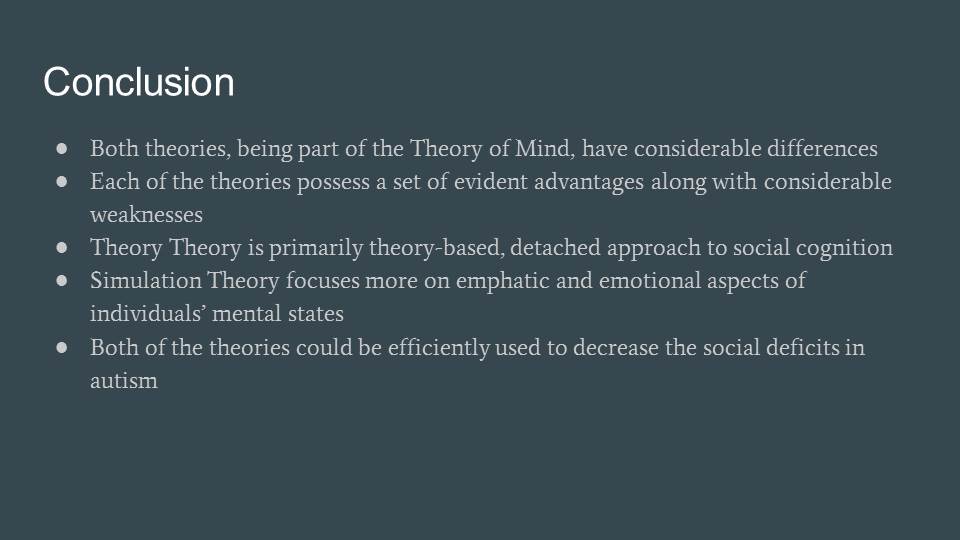
References
Dvash, J., & Shamay-Tsoory, S. G. (2014). Theory of mind and empathy as multidimensional constructs: Neurological foundations. Topics in Language Disorders, 34(4), 282-295.
Gergely, G., Bekkering, H. & Kiraly, L. (2002). Rational imitation in preverbal infants. Babies may opt for a simpler way to turn on a light after watching an adult do it. Nature, 415, 755.
Hamilton, A. F. de C. (2013). Reflecting on the mirror neuron system in autism: A systematic review of current theories. Developmental Cognitive Neuroscience, 3, 91-105.
Michlmayr, M. (2002). Simulation Theory versus Theory Theory: Theories concerning the ability to read minds. Web.
Saxe, R. & Kanwisher, N. (2003). People think about thinking people. The role of the temporo-parietal junction in “Theory of Mind”. NeuroImage, 19, 1835-1842.
Wiltshire, T. J., Lobato, E. J., McConnell, D. S., & Fiore, S. M. (2015). Prospects for direct social perception: a multi-theoretical integration to further the science of social cognition. Frontiers in Human Neuroscience, 8.